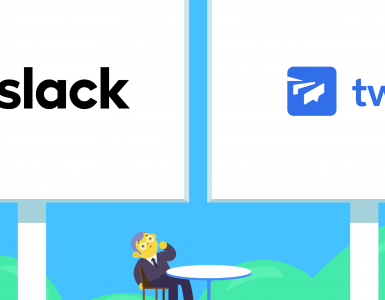In the last few years, tools like Zoom and Webex have soared in popularity. As more and more of us work remotely, it’s become crucial to have reliable software that makes it easy to hold meetings.
The key is to work out which tool is going to be best for your business, based on the kind of meetings you’ll be holding and the features you need.
With that in mind, in this blog post, we’ll compare Webex and Zoom, helping you to determine which platform will be best for your team in terms of collaborations and presentations. Plus, here at Chanty, we offer effective team communications that’ll help you to enhance collaboration at your business. Chanty offers secure unlimited messaging free forever.
What is Webex?
Over the years, Webex has continually evolved to integrate new features that enhance collaboration and productivity across various industries.
The software is really impressive! You can use it to organize video conferences, webinars, and events. Its robust set of tools, such as screen sharing and interactive whiteboards, allows teams to collaborate in real time with ease. The Webex Meeting Centre has lots of useful services that help companies stay connected. These services are designed to support secure, seamless communication whether you’re working remotely or from the office.
Plus, as it has been in business since 1995, you can be sure that it is a dependable solution. Its long history in the market underscores its commitment to reliability and continuous innovation in online communication.
What is Zoom?
Zoom is one of the most popular video conferencing tools in today’s market, known for some of the most helpful and innovative features. It offers powerful and consistent services, including group messaging, online meetings, Zoom rooms, and video webinars. Its intuitive interface and robust performance have made it a preferred choice for both small businesses and large enterprises alike.
This is a perfect tool for any type of business because it is affordable and facilitates effective communication. Its competitive pricing, combined with a suite of advanced features, ensures that businesses can maintain high-quality interactions without a hefty price tag. It is also optimized to ensure reliability and seamless service. Zoom’s commitment to quality makes it capable of handling large-scale meetings and webinars with ease, even during high-demand situations.
Webex vs Zoom: First impression
Both Zoom and Webex offer great video conferencing tools and features to help your business. They provide robust platforms that enable smooth communication and collaboration, whether you’re hosting a small team meeting or a large-scale webinar.
However, it is all about figuring out which one is the best fit for you. The ideal choice often depends on your specific needs, such as ease-of-use, security requirements, and integration with other tools.
Let’s compare both solutions in different key areas, so you can get a better understanding of how each platform might align with your business goals.
Webex vs Zoom: Video conferencing features
Zoom and Webex have a lot in common. They’re pretty similar in the video conferencing features they provide. Both of the solutions make it easy for you to send files, remove or add attendees, and co-browse. This means you can easily hold weekly meetings or give presentations.
No matter what sort of tool you choose, make sure you use a template for your business presentations so that everything looks professional and helps brand your business well.
As video conferencing is a fundamental service provided, it probably does not come as much surprise to learn that both Webex and Zoom are pretty much equal in this area.
Webex vs Zoom: Security
Video conferencing has taken off since remote work became the norm. The demand for virtual events has increased by 1000 percent, which shows how much we’re still using digital communication tools regularly. A lot of businesses have started using a mix of home and office work, which lets employees work from home when they want to, which has been useful during the recent lockdowns.
The increasing number of users did cause some issues for Zoom, though. The platform became more popular than they could have ever imagined. Because of this, a few security instances happened, which caused some meetings to be disrupted throughout 2020. However, the company has done a lot to rectify this, and such instances have not happened much in recent times.
To protect data, meetings are password protected. Zoom also uses AES-256 encryption for real-time content and TLX encryption for establishing means of communication.
When hosting a meeting, you can opt to verify participants one by one rather than simply having them join automatically. Hosts also have full control over screen sharing permissions.
If you run a healthcare business, you will be pleased to know that there is HIPAA compliant security.
Webex also impresses when it comes to its security offering. They provide locked personal room meetings, encrypted cloud recordings, and password-enforced meeting connections. The Webex lobby means the host has the power to decide who enters the meetings and when they do so.
Admins and meeting bots can revoke or grant participants access to meetings whenever they see fit.
Chanty is known for putting security first, so you can be sure of a secure experience, with frequent updates whenever vulnerabilities are spotted.
Webex vs Zoom: Ease of use
If you check out the reviews and feedback, you’ll see that people find Zoom much more user-friendly than Webex.
With Zoom, an account is not required to attend a meeting, which is a big plus if you are holding meetings with clients who may not use Zoom. However, you will need to download the Zoom meeting app to your mobile device or computer.
Zoom has just made its user experience even better with new features. These include Zoom IQ, which uses AI to provide insights and highlights in meetings. This makes it easier for users to engage with each other and to follow up on discussions.Zoom software updates are issued regularly. It’s always a good idea to make sure that the software is up-to-date. This will ensure your video conferences are stable and secure.
If you want to set up a meeting, you will need to sign up for a Zoom account. You can do this via single sign-on (SSO), Facebook, Google, or email. Once the account has gone live, you can invite others to your meetings and schedule meetings. The process is very easy, and the dashboard is user-friendly too, so you should not run into any issues.
The Webex application is downloaded and meetings are set up much like Zoom. One of the main differences between Webex and Zoom is that you have to download the software to attend a meeting on Webex.
Webex has been working on making its user interface easier to use by simplifying meeting layouts and adding features like real-time transcription and live translation, which help to cater to different user needs and improve accessibility.
You can create an account on Webex for free, but the registration process is a bit slower and more complicated than on Zoom.
So, where does Webex fall a little short of Zoom? Well, the meeting interface can be a bit more confusing for complete beginners. Plus, the registration takes longer, and the set-up instructions are quite clunky.
Webex vs Zoom: Pricing
Both Webex and Zoom provide a number of different plans so that you can choose one that is most suitable for your team’s communication and collaboration.
Webex rolls out a selection of four main pricing plans that can suit diverse requirements.
Starting with the Free Plan, users can enjoy basic HD online video meetings without any cost. Moving up, the Meet Plan, priced at $12 per month, allows for gatherings of up to 200 participants, making it a solid choice for larger teams.
For those seeking a more comprehensive solution, the Suite Plan combines telephony services with collaboration tools, starting at $22.50 per user, per month. Finally, there’s the Enterprise Plan, which offers a fully customizable experience, with tailored pricing based on specific organizational needs.
You will get telephony services and online video meetings with the Webex Meet + Call Plan. You then have the Enterprise Pan, which is completely customized to suit your specific needs.
Some other differences between the plans include meeting duration limits and participant capacity.
On the flip side, Zoom offers four different plans, with a free plan also available and their most expensive plan costing $18.32 per license, per month. Some key differences from plan to plan include participant capacity, meeting duration, and price.
One of the main differences between Zoom and Webex is the participant capacity limits on the different plans. The Webex Meet Plan, which costs $12, allows up to 200 participants. The Zoom Pro Plan, which is $12.49, only allows up to 100 participants.
If you wish to use Zoom but want to scale beyond 200 people, their Business Plan represents better value, with in-built support for as many as 300 participants.
Webex vs Zoom: Support
Last but not least, it is important to know that there is help available to you when you need it. Zoom Help Center is the only offered support for those who use the free Zoom plan.
However, if you upgrade to the Pro plan, you’ll get access to live chat support and the option to submit support tickets. Business and Enterprise plan users can also get help over the phone if they need it right away.
On top of that, Zoom has rolled out a chatbot called Bolt, which you can find on the Help Centre. It helps with common questions and connects users to live chat agents if needed.
When you decide to go down the Webex route, all users, even those on a free plan, can use the online Help Center. You will be able to use the phone or chat to contact a customer service agent if you have a paid plan.
If you go for the Enterprise plan, you will have a dedicated customer service agent who will be there to answer all of your questions and help you make the most of the platform.
Webex vs. Zoom: Which is best for you?
So there you have it: some clear differences between Zoom and Webex. We hope that this has helped you to effectively compare both platforms so that you can choose the right solution for your team. Remember, there is no right or wrong answer; it is all about partnering up with a tool that makes the most sense for your team.
Chanty, the better choice
While Zoom and Webex are two of the most well-known solutions around, it’s clear that Chanty ticks all the boxes mentioned above, and more. Features include code snippets with dev-friendly formatting, the ability to save innovative ideas with pins, highlight members with @mentions, and share some content types in a single app.
This article was originally written in 2022.









Add comment